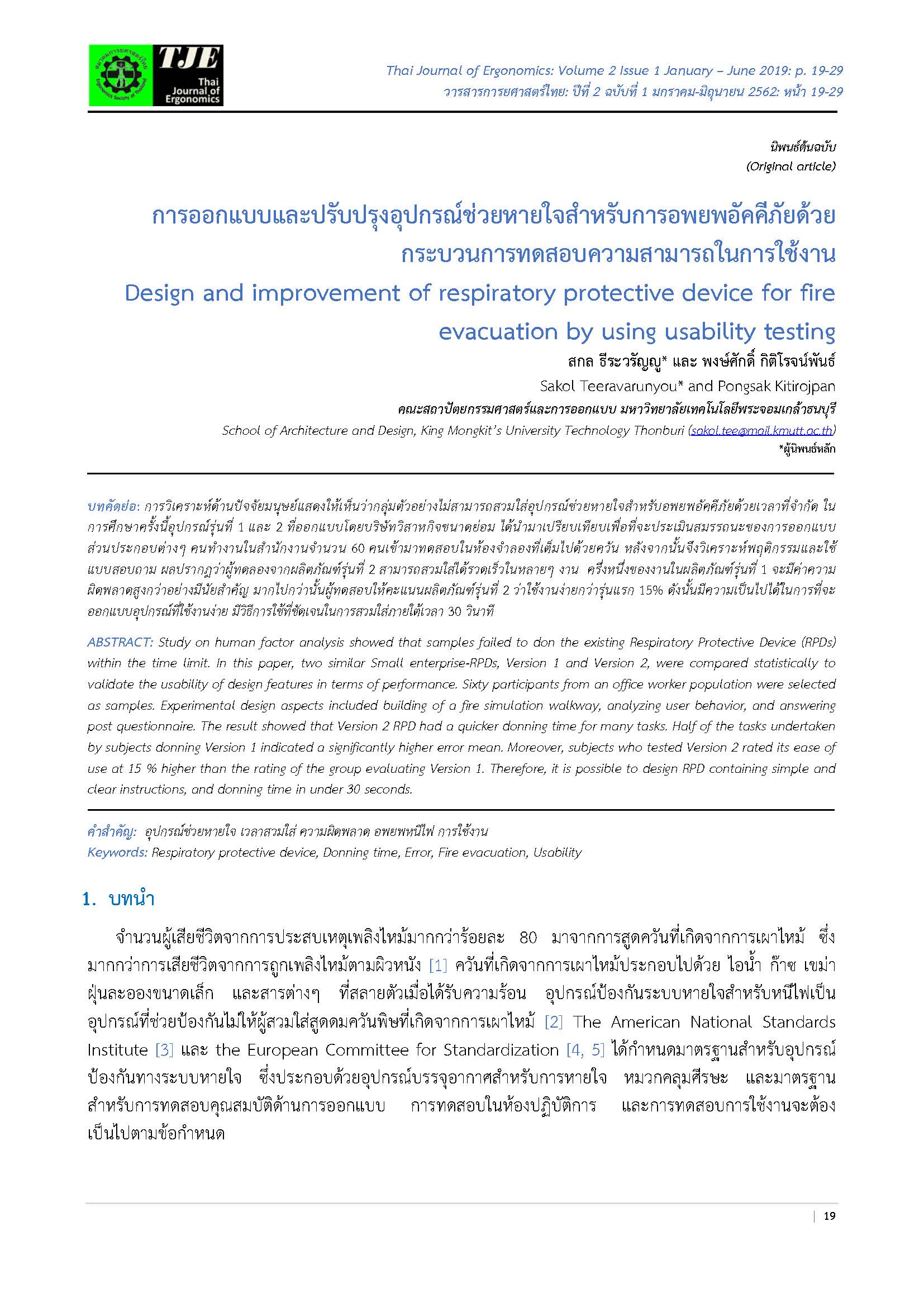Design and improvement of respiratory protective device for fire evacuation by using usability testing
Main Article Content
Abstract
Study on human factor analysis showed that samples failed to don the existing Respiratory Protective Device (RPDs) within the time limit. In this paper, two similar Small enterprise-RPDs, Version 1 and Version 2, were compared statistically to validate the usability of design features in terms of performance. Sixty participants from an office worker population were selected as samples. Experimental design aspects included building of a fire simulation walkway, analyzing user behavior, and answering post questionnaire. The result showed that Version 2 RPD had a quicker donning time for many tasks. Half of the tasks undertaken by subjects donning Version 1 indicated a significantly higher error mean. Moreover, subjects who tested Version 2 rated its ease of use at 15 % higher than the rating of the group evaluating Version 1. Therefore, it is possible to design RPD containing simple and clear instructions, and donning time in under 30 seconds.
Article Details

This work is licensed under a Creative Commons Attribution-NonCommercial-NoDerivatives 4.0 International License.
References
Gad S, Anderson R. Combustion toxicology. Boca Raton (Florida): CRC Press; 1990.
Johnson H, Khanna R. Human factors analysis of consumer personal protective quipment: emergency escape masks [Internet]. Usfa.fema.gov. 2007 [cited 8 February 2019]. Available from: https://www.usfa.fema.gov/downloads/pdf/escape-masks-human-factors.pdf
American National Standards Institute (2009). Air-purifying respiratory protective smoke escape devices. ANSI/ISEA 110-2009.
European Committee for Standardization (1993). Specification for respiratory protective
devices: self-contained open-circuit compressed air breathing apparatus. BS EN 137:1993.
European Committee for Standardization (2005). Specification for respiratory protective
devices: self-contained open-circuit compressed air breathing apparatus incorporating a hood for escape. Requirements, Testing, Marking. BS EN 1146:2005.
Plog B, Quinlan P. Fundamentals of industrial hygiene. Itasca, Ill.: National Safety Council; 2012.
Mackieh A, Çilingir C. Effects of performance shaping factors on human error. 1998. p. 285-92.
Funkhouser GE, Fairlie GW. Donning times and characteristics of infant life preservers: four representative types [Internet]. Faa.gov. 1991 [cited 8 February 2019]. Available from:https://www.faa.gov/data_research/research/med_humanfacs/oamtechreports/1990s/media/AM91-06.pdf
Nielsen J. Usability engineering. Amsterdam: Morgan Kaufmann; 2009.
MacDonald CV, Brooks CJ, Kozey J, Habib A. An ergonomic evaluation of infant life jackets: Donning time & donning accuracy. Appl Ergon. 2011;42:314-20.
Jones J, McMullen MJ, Dougherty J. Toxic smoke inhalation: Cyanide poisoning in fire victims. Am J Emerg Med. 1987;5(4):317-21.
Khanna R. Evaluation of consumer personal protective equipment: emergency escape masks [Internet]. Usfa.fema.gov. 2007 [cited 8 February 2019]. Available from: https://www.usfa.fema.gov/downloads/pdf/escape-mask-evaluation.pdf
Rubin J, Chisnell D. Handbook of usability testing. Indianapolis, IN: Wiley Pub.; 2008.
Fundamentals of fire fighter skills. Sudbury, MA: Jones and Bartlett; 2009.
Noldus LPJJ. The Observer: A software system for collection and analysis of observational
data. Behav Res Methods Instrum Comput. 1991;23(3):415-29.
Stephens MA. EDF Statistics for goodness of fit and some comparisons. JASA. 1974;69:730-7.
Box G, Cox D. An Analysis of Transformations (with Discussion). J R Stat Soc Series B Stat Methodol. 1964;26:211-52.
Marras W, Karwowski W. The occupational ergonomics handbook. Boca Raton, Florida.: Taylor & Francis; 2006.
Teeravarunyou S, Kitirojpan P. The usability of respiratory protective device on instruction with images : International Conference on Imaging and Printing Technologies; 2011 Aug 17-20; Bangkok, Thailand.


